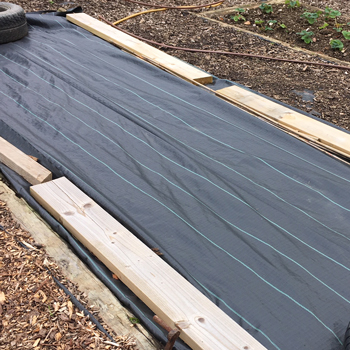Over the next few weeks it’s a good idea to think ahead to the next growing season and get a few key jobs done…

Compost Pile
Add as much as you can to your active compost pile now – grass clippings, raked up leaves, kitchen veg scraps, and old plants. Once you’ve added as much as you can, turn the pile with a garden fork, and ideally cover it as this will help to keep it from getting too wet and will also help to retain a little warmth for a speedier break-down process. Doing this now will hopefully give you some good, usable compost material for next autumn.
After that, you can start creating a new pile with any new materials, and this will be your active compost pile for topping up throughout next year, for the following autumn.

Pull up weeds
While the ground is quite soggy and temperatures aren’t too cold, it’s a good idea to pull up weeds. The roots will come out more easily and you can clear beds fairly quickly. Doing this now will remove/reduce habitat for overwintering pests and diseases, which in turn will give you a cleaner start next season, hopefully with fewer slugs and other pests to contend with!

Install water butts
With all the rain to come over the next few months, as we so often enjoy over the winter, it’s a really good idea to collect rainwater to use during dry spells in the veg garden next year. It’s by far the most eco-friendly way of providing water to your veggies! A simple water butt, gutter and downpipe structure will do the job nicely – even better if you can set it up by the garden shed for easy access with a watering can next year.

Cover empty beds
If you’re not growing over the next few months, then cover the bare soil with black polythene or cardboard, or with an organic mulch to protect the soil. This has the added benefit of helping the soil to warm up faster and earlier on in spring, which in turn gives newly planted veggies a bit of a head start as they will thrive with the extra warmth.
If using polythene, make sure you secure it down really well at the sides, as pictured, as this will stop it from blowing around on windy days and keep it intact so that you can re-use it year after year.

Plan your patch
On the colder, wetter days during the next few months, take cover and get cosy indoors, grab a notepad and make a planting plan for next year. Try to rotate crops a little bit to help keep the soil healthy. You can consult our online growing guides for spacing ideas, or refer to our printed growing guide if you still have one from this season. Keep in mind plant height and the position of the sun, putting taller plants like beans and corn at the back. Shady areas are good for any leafy crops like lettuces, rocket and spinach as they will grow just as quickly but will benefit from the slightly cooler soil, being less likely to bolt.

